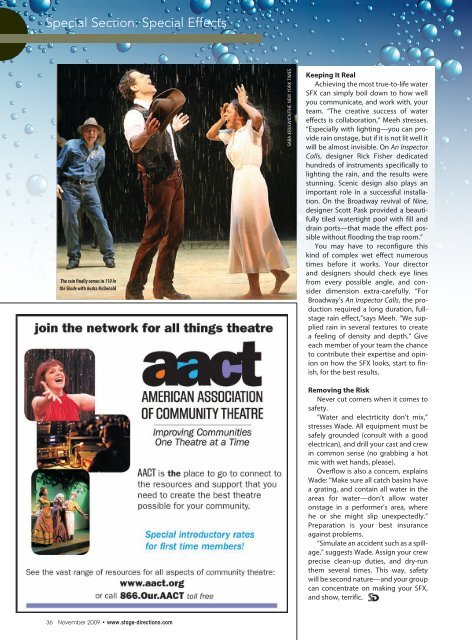Download a PDF - Stage Directions Magazine
Download a PDF - Stage Directions Magazine
Download a PDF - Stage Directions Magazine
Create successful ePaper yourself
Turn your PDF publications into a flip-book with our unique Google optimized e-Paper software.
Special Section: Special Effects<br />
The rain finally comes in 110 In<br />
the Shade with Audra McDonald<br />
Sara Krulwich/The New York Times<br />
Keeping It Real<br />
Achieving the most true-to-life water<br />
SFX can simply boil down to how well<br />
you communicate, and work with, your<br />
team. “The creative success of water<br />
effects is collaboration,” Meeh stresses.<br />
“Especially with lighting—you can provide<br />
rain onstage, but if it is not lit well it<br />
will be almost invisible. On An Inspector<br />
Calls, designer Rick Fisher dedicated<br />
hundreds of instruments specifically to<br />
lighting the rain, and the results were<br />
stunning. Scenic design also plays an<br />
important role in a successful installation.<br />
On the Broadway revival of Nine,<br />
designer Scott Pask provided a beautifully<br />
tiled watertight pool with fill and<br />
drain ports—that made the effect possible<br />
without flooding the trap room.”<br />
You may have to reconfigure this<br />
kind of complex wet effect numerous<br />
times before it works. Your director<br />
and designers should check eye lines<br />
from every possible angle, and consider<br />
dimension extra-carefully. “For<br />
Broadway’s An Inspector Calls, the production<br />
required a long duration, fullstage<br />
rain effect,”says Meeh. “We supplied<br />
rain in several textures to create<br />
a feeling of density and depth.” Give<br />
each member of your team the chance<br />
to contribute their expertise and opinion<br />
on how the SFX looks, start to finish,<br />
for the best results.<br />
Removing the Risk<br />
Never cut corners when it comes to<br />
safety.<br />
“Water and electrticity don’t mix,”<br />
stresses Wade. All equipment must be<br />
safely grounded (consult with a good<br />
electrican), and drill your cast and crew<br />
in common sense (no grabbing a hot<br />
mic with wet hands, please).<br />
Overflow is also a concern, explains<br />
Wade: “Make sure all catch basins have<br />
a grating, and contain all water in the<br />
areas for water—don’t allow water<br />
onstage in a performer’s area, where<br />
he or she might slip unexpectedly.”<br />
Preparation is your best insurance<br />
against problems.<br />
“Simulate an accident such as a spillage,”<br />
suggests Wade. Assign your crew<br />
precise clean-up duties, and dry-run<br />
them several times. This way, safety<br />
will be second nature—and your group<br />
can concentrate on making your SFX,<br />
and show, terrific.<br />
36 November 2009 • www.stage-directions.com

















